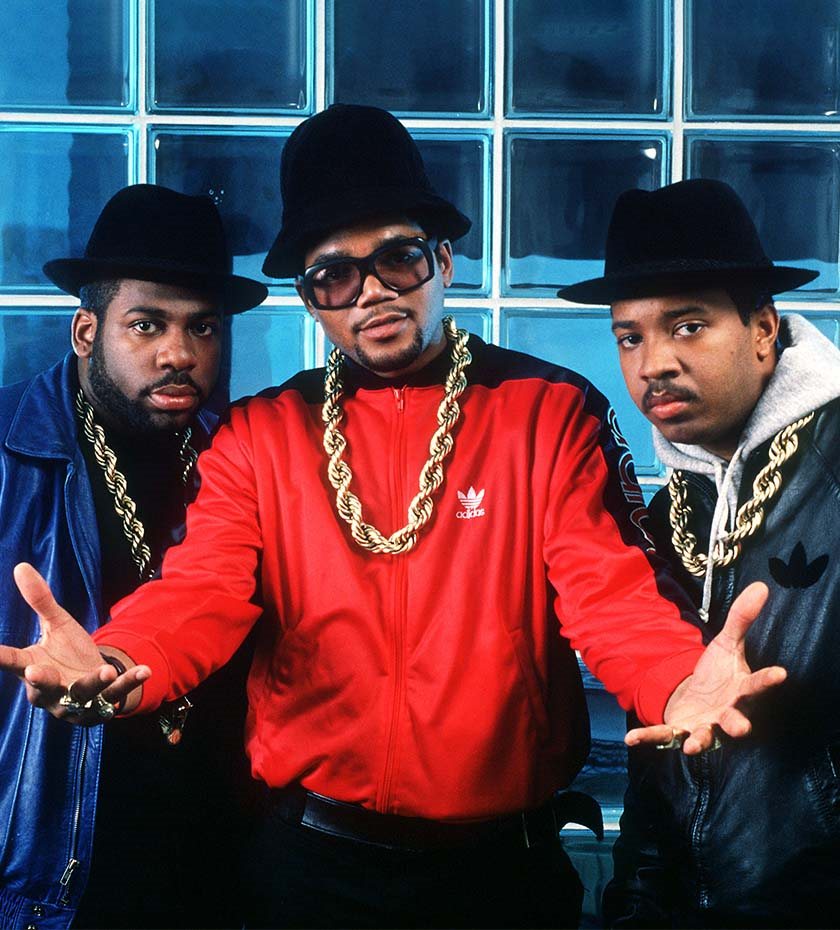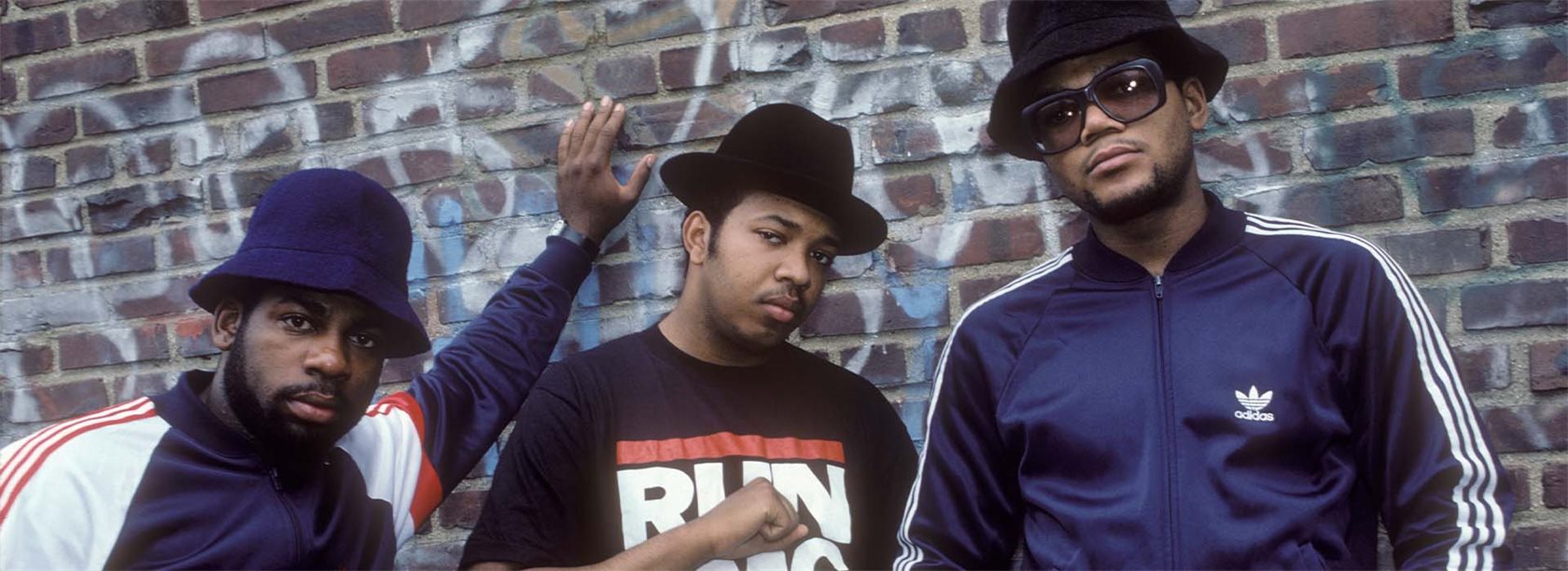Run DMC

Run DMC consists of Jason Mizell, Darryl McDaniels and Joseph Simmons. The group is considered by many to be one of the most influential groups in hip-hop history and culture. They have pioneered the new school hip hop genre alongside the Beastie Boys and LL Cool J, among others. Another point where they pioneered was in the group's focus on the relationship between the DJ and the MC - that is, the important collaboration between a DJ that lays the foundation for what the MC raps about. And let's not forget to mention their style and the impact it has had on modern day rappers.
From Two-Fifth Park to the Billboard 100
Joseph Simmons started rapping because of his older brother Russell Simmons, who at the time was a DJ for a guy named Kurtis Blow. Before long, Joseph and Kurtis started rapping together. One thing led to another, and after shifting his focus from sports to a DJ booth, the group's other member, Darryl McDaniels, was easy for Joseph to convince. The two began hanging out together in that particular Two-Fifths Park, hoping to get the opportunity to rap for some of the DJs who often played there. One of the DJs who often played there went by the stage name "Jazzy Jase," but went by the real name Jason Mizell. There we have all three main characters together for the first time in Two-Fifth Park, but it would be a few years before they produced music together.

Joseph had previously tried to persuade his brother, Russell, to help produce a track for him and McDaniels, but he wouldn't help them because he didn't like the way McDaniels rapped. But in 1983 they managed to persuade Russell. They recruited Jason Mizell, whom they had met in Two-Fifth Park a few years earlier, as their DJ. He now went by the stage name Jam Master Jay.
The name, Run DMC, comes from Joseph's DJ name, DJ Run. The name originated during the collaboration with Kurtis Blow, where he, Joseph, went by the name "DJ Run, Son of Kurtis Blow". Run they then combined with McDaniels' "Devastating Microphone Controller" - DMC. Boom! One of hip-hop history's most seminal groups, Run DMC, was born.
Let's take a quick rundown of the group's albums, a lightning discography if you will:
In 1983 the group signed with Profile Records and shortly after released the single "It's like That/Sucker MC's". The following year, in 1984, they released the album "Run DMC". The boys did not sit on their hands and already in 1985 they released the album "King of Rock". On the album, the group began to play with mixing several genres. For example, the album title is a reference to the track "Can I Rock It Like This" which is sampled with rock music, while the track "Roots, Rap, Raggae" (an appreciative nod to Bob Marley's "Roots, Rock, Raggae") mixes rap and dancehall.
MTV had become a thing in the meantime, and the music video for "Rock Box" was the first hip-hop video ever shown on the channel.

1985 is also the year of the release of the film "Krush Groove". It is about how Russell Simmons builds his record label Def Jam Recordings. Run DMC is in the film, along with Prince, LL Cool J and the first successful white rap group, the Beastie Boys. The film clearly marks how hip-hop culture was becoming increasingly popular in its time.
In 1986 Run DMC released their third album "Raising Hell". The album achieved double platinum. Run DMC is also the first hip-hop group ever to receive a Gold record and subsequently a Platinum record. Run DMC is perhaps best known for "It's Tricky", "King of Rock" and "Walk This Way" made in collaboration with the legendary rock band Aerosmith. The Run DMC version, incidentally, charted higher on the Billboard 100 than Aerosmith's own original version of the song. "Raising Hell" is Run DMC's best-selling album, as upon its release, the album sold over 3 million copies in its first year alone.

High to fly, deep to fall
In 1988, Run DMC released the album "Tougher Than Leather", featuring tracks like "Beats to the Rhyme", "Mary, Mary" and "Run's House". The latter would later be the name of a TV series following Run and his family. The album is not as well received as the previous ones, and things start to go downhill.
In 1990, the group releases "Back from Hell", which receives scathing reviews and is described as their worst album to date. Unfortunately, it's not just on the music side that things start to go downhill. The three members of Run DMC also have their personal lives to contend with. McDaniels starts drinking a little too much, Jason first drives into a serious accident, but survives, only to be shot twice in another episode, and survive this time too. Simmons is accused of raping a college student in Ohio. Things begin to fall apart a bit and the group's three members turn their eyes to the church to try to find stability. Joseph Simmons actually becomes a pastor a few years later. Their recent attachment to the church can be heard in the sound of their next album after a few years break, "Down with the King".
Run DMC comes to an abrupt end as a group when Jam Master Jay is shot and killed in his music studio (where 50 Cent, among others, has recorded tracks) in Queens, New York, in 2002. Since then, there have been occasional reunions, including in 2012 during Jay-Z's Made in America festival.
It’s all about the looks
Former rappers like Afrika Bambaataa and Grandmaster Flash wore clothes that were mostly reminiscent of those favoured by disco dancers and glam rockers: tight leather trousers, shirts open to mid-chest, big hats, rhinestones, leather boots. But three up-and-coming rappers were about to change that forever. Run DMC were pioneers in introducing a more street style and culture to hip-hop. They wore big Cazal sunglasses, Kangol hats, leather jackets, varsity jackets, big rope gold chains and Adidas sneakers. Adidas in particular is unique to the Run DMC. The album "Raising Hell" features the track "My Adidas," which led to a $1.6 million sponsorship deal with Adidas, which was very new and groundbreaking for its time. In the same year as the sponsorship deal was signed, it boosted sales of Adidas Superstar to half a million pairs in the US market alone. Today, sponsorship deals and collaborations between brands, designers and rappers are a common, ingrained and almost inevitable phenomenon in the music industry.
The group's style came to define the next decades of hip-hop culture, and references from hip-hop and rap culture can still be drawn to Run DMC's style today. If you want to recreate Run DMC's iconic style, swing by your qUINT and shop for Adidas sneakers, baggy pants and varsity jackets.
Discography:
Run DMC (1984)
King of Rock (1985)
Raising Hell (1986)
Tougher Than Leather (1988)
Back from Hell (1990)
Down with the King (1993)
Crown Royal (2001)